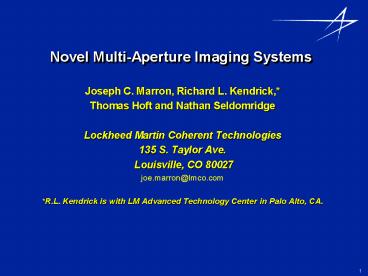Novel MultiAperture Imaging Systems - PowerPoint PPT Presentation
1 / 23
Title:
Novel MultiAperture Imaging Systems
Description:
1. Novel Multi-Aperture Imaging Systems. Joseph C. Marron, Richard L. Kendrick,* Thomas Hoft and Nathan Seldomridge. Lockheed Martin Coherent Technologies. 135 S. ... – PowerPoint PPT presentation
Number of Views:219
Avg rating:3.0/5.0
Title: Novel MultiAperture Imaging Systems
1
Novel Multi-Aperture Imaging Systems
- Joseph C. Marron, Richard L. Kendrick,
- Thomas Hoft and Nathan Seldomridge
- Lockheed Martin Coherent Technologies
- 135 S. Taylor Ave.
- Louisville, CO 80027
- joe.marron_at_lmco.com
- R.L. Kendrick is with LM Advanced Technology
Center in Palo Alto, CA.
2
Presentation Outline
- Motivation for Multi-Aperture Active Imaging
- Technical Approach
- Experimental Results
- Four Aperture Combiner
- Extended Range Testing
- Conclusion
3
Distributed Aperture Active Imaging
Imaging systems are advanced significantly by
incorporating array concepts into receivers and
transmitters
THEN
NOW
FUTURE
- Features
- Passive
- Segmented Primary
- Common Secondary
- Features
- Passive
- Segmented Primary
- Separate Secondaries
- Optical Combiner
- Features
- Active
- Segmented Primary
- Separate Secondaries
- Digital Combiner
- Also 3D and DE
4
r -Space Image Formation
Source
OPD1
rs
y
x
r
z
OPD2
Object Surface
rd
Detector
Objects Complex 3D Reflectivity
r-Space Measurement
3D Fourier Kernel
Unit Vectors
"Three-Dimensional Lensless Imaging Using Laser
Frequency Diversity," J.C. Marron and K.S.
Schroeder, Applied Optics, 31, 255-262, 1992.
5
3D Fourier Fill
Source
rs
Detector Array
Object Surface
rd
2D Detector Array
3D Fourier Transform
l
3D Image
6
Resolution
2D Detector Array
3D Image
3D FFT
W
Dl
capable of microns
Z resolution
X,Y resolution
equivalent to lens of size W
7
Synthetic Aperture Imaging Taxonomy
Data Space 3D (angle, angle, wavelength)
b
Image Space 3D (x,y,z)
l
a
y
z
x
3D Fourier Transform
3D Parameterized
3D Imaging
2D Imaging
Two-Wavelength Imaging
Coherent 2D Aperture
- Angular Aperture Synthesis
- Small speckle size
- Aperture fill detector arrays
- Increased resolution multi- aperture
- More wavelengths better 3D
Multi-Wavelength Imaging
Angle-Angle Data Slices
Angle-Angle Data Slice
Angle-Angle Data Slices
Phase-Difference Z(x,y) Image
Angle-Angle Projection Image
3D Image s(x,y,z)
Two-Receiver Interferometric SAR
Multi-Receiver Interferometric SAR
SAR Imaging
- Translational Aperture Synthesis
- Large speckle size
- Aperture fill airplane motion
- Increased resolution more bandwidth
- Multi-static better 3D
Range-Angle Data Slice
Range-Angle Data Slices
Range-Angle Data Slices
Range-Angle Projection Image
3D Image s(x,y,z)
Phase-Difference X(y,z) Image
8
Distributed Aperture Active Imaging
- Features
- Large aperture receiver
- Fine-resolution imaging at extended range
- Modular system
- System simplified with modular approach
- Digital image formation
- Allows correction of optical misalignment errors
- Atmospheric Compensation
- Apply low-order correction to sub-apertures
Distributed Aperture Active System
Target
9
Presentation Outline
- Motivation for Multi-Aperture Active Imaging
- Technical Approach
- Experimental Results
- Four Aperture Combiner
- Extended Range Testing
- Conclusion
10
Technical Approach
1. Target flood illuminated coherent images
recorded by sub-apertures
2. Image reconstructed using digital imaging
methods
11
Technical Approach
1. Target flood illuminated coherent images
recorded by sub-apertures
Transceiver Module
Detector
LO Spot
Array
Object Return
Field Stop
Pupil
(Intermediate Image)
Spatial Heterodyne Detection
- Coherent Image Recorded
- Complex-valued
Received Data
Fourier Transform
12
Technical Approach
2. Image reconstructed using digital imaging
methods
- Digitally formed image sensitive to return-path
turbulence - Aberrations are determined directly using
coherent data - Auto-focus based on sharpness maximization
- Robust high-speed performance
13
Autofocus Process
Initial Aberrated Image
Coherent Data
Amplitude
Recorded Data
Applied Phase Correction
Phase
- Iteration (25-30)
- Good Keep
- Bad Try again
Focused Image
14
Presentation Outline
- Motivation for Multi-Aperture Active Imaging
- Technical Approach
- Experimental Results
- Four Aperture Combiner
- Extended Range Testing
- Conclusion
15
Demonstration Experiments
- 4 aperture system
Sensor Table
Target Table
Laser
Collimator (places target at infinity)
Target
LO
Cam 2
Sub-Aperture Primaries (2 of 4)
Cam 1
LO
Sub-aperture Primaries
Sensor Table Front View
LO Fibers
16
4 Aperture Modular System
- Extended Scene Images
- Object 1951 USAF Resolution Test Chart
Example Synthetic Pupil
Example Image
- Obscurations
- Collimator secondary
- Sub-aperture secondaries
17
4 Aperture Modular System
1 sub-aperture, 1 realization
1 sub-aperture, 8 realizations
4 sub-apertures, 8 realizations
4 sub-aps, 8 realizations, filtered
18
3D Imaging
- Base mode for coherent imaging
- Reflectivity image
- Also provides for 3D imaging
- Useful for ID, aimpoint selection
- Other discriminants follow
Reflectivity Image
Composite Image
3D Image (color-encoded)
19
Table Mountain Experiments
- Demonstration of multi-aperture imaging over
extended range (0.5 km) - Extreme telescope misalignment
- Extreme atmospheric phase aberrations
Multi-Ap Telescope
Table Mountain Test Facility
20
Table Mountain Experiments
Telescope Illuminator Laser
Target
Laser Height 40
Target Height 52
21
Table Mountain Experiments
- Point target results
Corrected Image Strehl 0.63 (wavefront rms
0.11 waves)
Perfect System
Initial Image Strehl 0.20
Applied Phase
22
Table Mountain Experiments
- Extended scene
- Motorcycle license plate at 0.5 km
Single Coherent Image
FFT
Raw Data
Object
20 images averaged To produce incoherent image
23
Summary
- Distributed Aperture Active Imaging
- Allows fine resolution digital imaging
- Reduced volume, weight
- Features of Approach
- Digital image formation
- Corrects for optical misalignment errors
- Atmospheric compensation
- Apply low-order correction to sub-apertures
- Significant progress reported
- Laboratory and field demonstrations of imaging
performance































